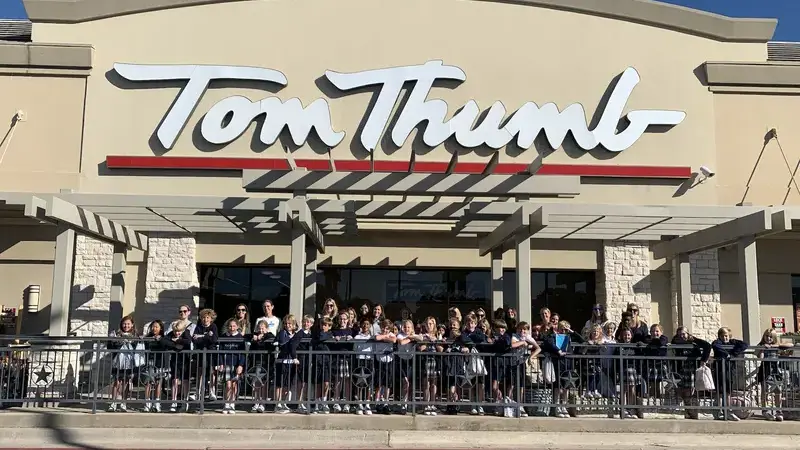Public Service Builds Lives of Purpose
April 29, 2024
A key element in developing an educated conscience is stepping outside one’s perspective to view and gain an understanding of life as it exists for others. Starting in Beginner, our students are taught the importance of kindness, servitude, selflessness, and integrity. As these young stewards progress in their scholastic careers, they become more informed, aware, and action-oriented, seeking to implement positive change in the world around them. Through a series of educational initiatives, students are gradually prepared to lead purposeful lives via community service learning and involvement, which includes reflective discussions, service activities, volunteerism, philanthropic projects, and partnership engagement.
As a whole, ESD’s Community Service Learning program focuses on five key issue areas—housing stability, food security, quality health, education equity, and environmental sustainability. These areas are derived from student interest, the most recent equity report for Dallas County, and the current UN Sustainable Development Goals for 2030.
“Divisional work is designed to mirror ESDistinction. We start by making our students aware of the issues in lower school, exploring root causes while addressing conceptions and misconceptions in middle school, and finally using hard and soft skills to design solutions to social issues in upper school,” explained Courtney Phelps, Director of Community Service Learning.
| Read More |
|---|
|
In lower school, ESD educators connect conceptual understanding to practice by teaching lessons in the classroom and allowing students to further explore its meaning through service activities and trips. For instance, the third grade successfully completed their annual canned food drive to support the North Dallas Shared Ministries food bank, wherein they participated in a shopping trip and put their mathematical estimation skills to the test by purchasing three meals for a family of four on a set budget. During this time, students learn about needs vs. wants, budgeting living expenses, saving financially, and donating to organizations. Students then led a campus-wide canned food drive, and they hand-delivered 506 bags of food and toiletries - an impressive 3,715 items in total - to North Dallas Shared Ministries, where they not only learned about their food program but the many services they provide to meet families’ needs. Early childhood students practiced kindness by writing thank you letters and sharing gratitude for the ESD staff, facilities team, faculty, security team, and administration. Primer also adopted collecting birthday party supplies for homeless youth in partnership with The Birthday Party Project. At early ages, our students understand that they can have an impact, however big or small, and make a difference in the lives of others. Middle school students similarly connect class lessons to actionable items. Yet, the Community Service Learning program becomes more structured, emphasizing the five previously mentioned issue areas and providing an official introduction to the global goals. These goals are then reiterated throughout their middle school experience, with sixth and seventh graders honing their understanding of the issues from a local and global perspective and then further applying that knowledge in a hands-on service project with a local organization in eighth grade. At each grade level, students may tackle one of the larger issues, engage in simulations to broaden their perspective and build empathy, utilize designated data corresponding to their service project, conduct advisory conversations, and carry out applicable projects. For instance, seventh graders participate in a service project focused on housing stability and homelessness. They discuss the different types of homelessness, the availability of affordable housing, and its overall impact on our community. Before taking their service trip to different housing shelters across DFW, they hear from a panel of organizations and reflect on the entire project and experience with an escape room designed to highlight the many resources an individual and community requires to escape homelessness. During this stage, students begin taking the initiative by organizing drives, leading campus-wide projects through service clubs, visiting various nonprofit organizations, and devising other methods of involvement that best suit their interest areas. Middle schoolers also share their community service experiences with an audience of peers and faculty during chapel, as well as conduct leadership interviews with nonprofits and the ESD leadership team to further develop a sense of servant leadership and stewardship. In upper school, students apply the knowledge and experiential learning they’ve culminated over the years by dissecting their individual passions and values, reflecting on prominent issues within their community, conducting organizational research and connecting with nonprofit leadership teams, as well as carrying out service initiatives that directly impact the cause at hand. Freshman year starts with the students as they reflect on their values and passions, connect local issues to global goals, and envision how they can have an impact as individuals. During this time, students focus on direct service, such as going off-campus, volunteering in their service area of interest, and creating a service project plan they might want to implement independently. “We try to give them opportunities as they enter upper school to start figuring out where they want to volunteer to earn their service hours. They have a better frame of reference in connecting it to their own values and interests, not just what other people are doing, so it’s really about their passion and purpose,” Phelps said. “The passions and values project for freshmen gives them an opportunity to explore, ‘What if I were to make an impact in some way to address this issue? What would that look like?’ The hope is that they use this to create impactful service experiences that lead them on a journey to engage with their community in ways they might not have thought about before.” Once students develop the groundwork of their service area, they begin sophomore year with advocacy by using their voices to promote a cause or issue. They can devise a campaign, PSA, town hall announcement, make a website, and have pop-up educational services within the community. Whichever avenue they choose will then be executed throughout the school year, followed by a presentation during a special programming day in February that educates fellow students and faculty about the cause, highlights what they learned during their project, exhibits impactful results, and enacts a call to action. In middle through upper school at ESD, students are also placed in advisories, where they collaborate with eight to ten peers and a faculty or staff member in their studies, school projects, and anything else students may need assistance with. These advisories are particularly significant in Community Service Learning due to the opportunity it presents for students to engage with a trusted group of peers while sharing differing perspectives in an open dialogue and learning from one another in the process. “We take deeper dives as they advance to ask the question, ‘What’s really happening in my community? How effective is the work that I’m doing? Is it a larger conversation that needs to happen at the political level? How do I engage? What level of responsibility do I have?’ So they have all those conversations at different points in upper school and talk with their peers about it because a lot of the work is done in advisory. At some point, you have to be able to advocate for what you’re passionate about. How do you convince others to engage in the work? How do you come to a consensus as a group of 10?” Once students enter their junior year, they are placed in their final advisories, wherein a group of students chooses one nonprofit organization to get involved with as a team for the Junior Philanthropy Project. Students remain focused on the five issue areas introduced to them in middle school, serving one area through one organization. Once an advisory decides on an organization, they begin exercising philanthropy, in which students learn how to use financial resources effectively while ensuring that the nonprofit is also delegating their money wisely. To do this, students conduct site visits, interview the organization’s development teams, and begin to understand how dollars work within that particular setting and social issue. They continue participating in year-long local service opportunities, culminating and presenting their findings to the junior class in April. Additionally, each advisory must designate where they would like a generous $5,000 grant donated by the Puckett Family and managed through the Dallas Foundation to be applied. Their dedicated efforts, accumulated data, and unwavering conviction toward their service project will inevitably impact whether or not the junior class chooses that organization for their Senior Class Service Capstone project. “At each grade level, they have a different understanding of how they can engage in the community. It promotes the three levels of engagement that they have already established freshman through junior year,” Phelps notes. “Now, senior year in their capstone, they have to be able to effectively execute all three of those things for one organization as a class.” In senior year, students utilize everything they’ve practiced in upper school thus far—direct service, advocacy, and philanthropy—to serve one organization for their Senior Class Service Capstone project. The two front-running nonprofits for the 2024-25 school year are Interfaith Family Services and Family Gateway, who serve families in crises of poverty and homelessness, respectively. For their capstone, 100% of the senior class must volunteer directly to gain hands-on experience, host a fundraiser to contribute financially, and hold some iteration of an in-kind drive to collect high-need items. Throughout the students’ entire experience at ESD, they are not only learning and exercising various methods of community service and involvement, but they are also connecting it all to a larger universal goal. By doing this, our children adopt selfless modes of thinking and carry that into adulthood, wherein they have access to more resources, additional skill sets, and the capacity to work more effectively and have a more significant impact. Phelps explained that the most rewarding aspect of implementing such a well-structured learning experience is how every opportunity shapes students into lifelong change-makers. “This really gives me an opportunity to share the passion I have for service while teaching others how to do the same work based on their passions on a greater scale. Education is the foundation, and if I’m teaching them how to care for other people, consciously think about the issues that are occurring, and not approach it from a patchwork or bandage stance, then I think that I can make a greater impact than if I’m just working at one organization that only focuses on one issue. Now I get the opportunity to plant the seed for a lifetime commitment to service where they will be the next generation to positively impact our communities in several different ways.” |






